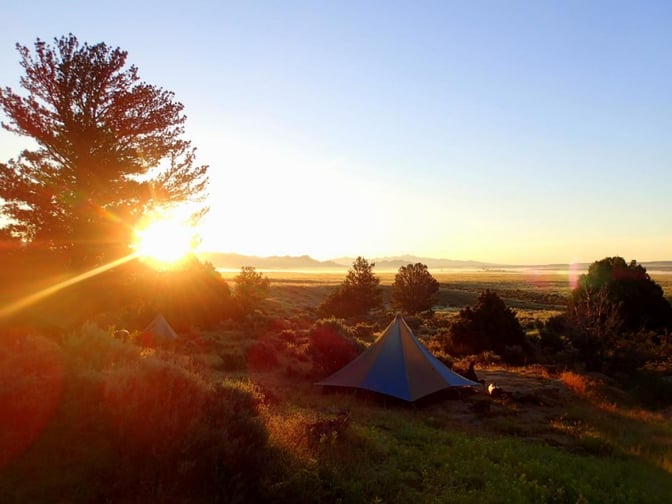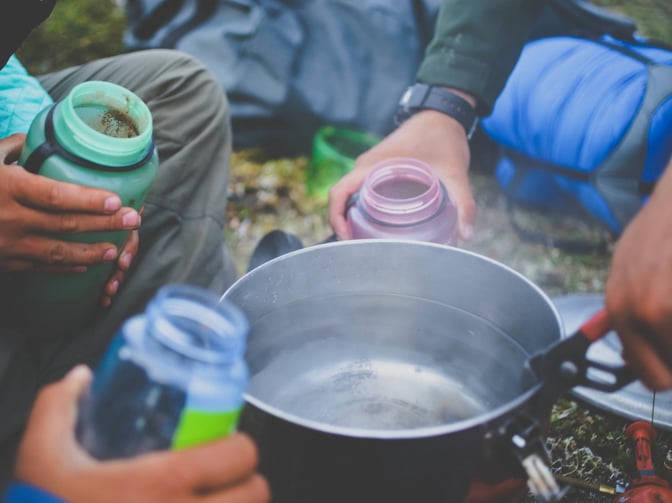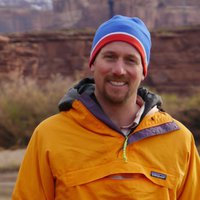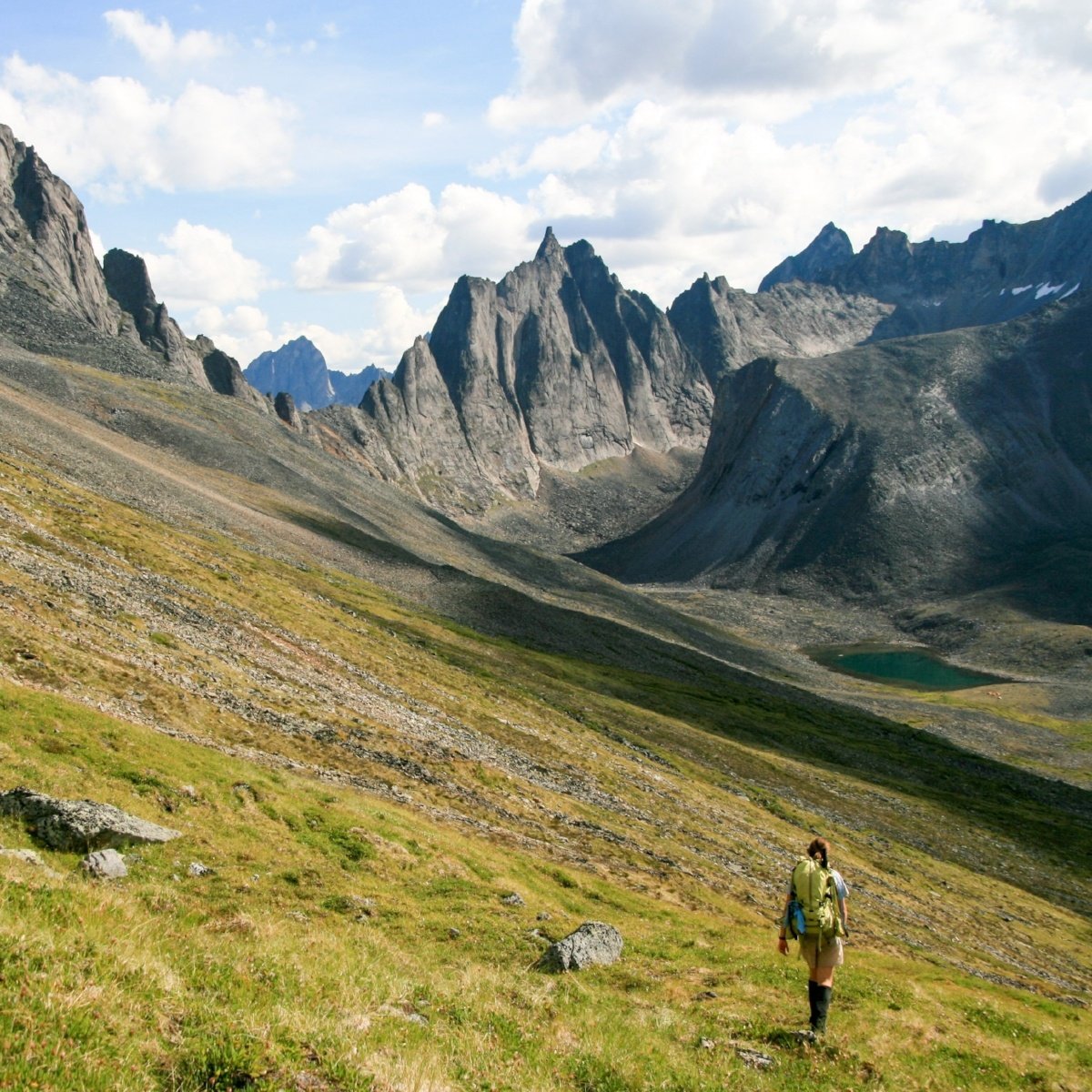
The smell of the morning coffee your co-instructor is brewing wakes you from a great sleep. This is immediately followed by a loud scream from one of the student camps. It’s a spring morning in the Gila Wilderness in New Mexico, and you’re about to earn your pay.
You bolt out of your sleeping bag, stumble and fall in the process, and curse your clumsiness. Your co-leader runs to the sound of the howls and commotion. You grab the first aid kit, pull on your shoes and a layer of clothes. While walking to the scene you keep your breathing under control and your head up while your eyes scan the camp. You mentally review the scene size-up and initial assessment.
You find one of your students, 25-year-old Denise, howling in pain and trying to pull off her long underwear while another student is pouring water on her foot. At the same time one of the students is standing to the side sobbing “I’m sorry. It was an accident.” Apparently, he tripped while carrying a pot of hot water and spilled the water into the patient’s boot.
You quickly figure out that this is a spilled hot water burn and continue the cool water irrigation and help the patient to pull off long underwear, socks, and shoes. After 20 minutes of water irrigation, which required several relays of people back and forth to the stream (which of course was more than 200 meters from the camp) you decide it’s time for a complete patient assessment.
SOAP Report
Subjective
The patient is a 25-year-old female who had a pot of boiling water spilled on the back of her left lower leg and foot.Objective
Patient Exam
The patient has 5% superficial burns to the back of the left lower leg and a 2” x 3” partial thickness burn to the heel of the left foot. The burn is not circumferential. The blister has ruptured. CSM is good in the left toes. No other injuries found.
Vital Signs
|
Time |
7:00 AM |
7:30 AM |
|
Level of Responsiveness (LOR) |
A+Ox4 |
A+Ox4 |
|
Heart Rate (HR) |
72, strong, regular |
68, strong, regular |
|
Respiratory Rate (RR) |
12, regular, unlabored |
12, regular, unlabored |
|
Skin Color, Temperature, Moisture (SCTM) |
pink, warm, dry |
pink, warm, dry |
|
Blood Pressure (BP) |
radial pulse present |
radial pulse present |
|
Pupils |
PERRL |
PERRL |
|
Temperature (T°) |
not taken |
not taken |
History
|
Symptoms: |
None other than the pain from the burn |
|
Allergies: |
Reacts strongly to poison ivy. No exposure. |
|
Medications: |
No regular medications. We have started the patient on ibuprofen 600 mg every 6 hours for pain. |
|
Pertinent Hx: |
Patient has no relevant medical history. |
|
Last in/out: |
Patient is well hydrated. She has not eaten breakfast yet today nor has she had a bowel movement. Urine is clear. |
|
Events: |
Patient was cooking and had hot water spilled on her leg. |
Pause here!
What is your assessment and plan? Take a few minutes to figure out your own assessment and make a plan before you read further.

Assessment
- Patient has 5% superficial burns to the back of the left lower leg and a 2” x3” partial thickness burn to the heel of the left foot.
Plan
- We will dress the partial thickness injury with the 2nd Skin® in our kit and clean gauze.
- The patient is uncomfortable. It will be difficult to keep the wound clean. The patient cannot wear their boots. We are concerned with the location of the partial thickness burn on the heel. We will evacuate the patient.
- The patient is able to walk in running shoes with the heel folded down. We will hike to the trailhead, which we should reach tomorrow, and have this burn evaluated by a medical professional.
Anticipated problems
- Wound infection.
- Inability to walk.
Comments
Other than a sunburn, the most common cause of a burn on a NOLS course, and on many wilderness trips, is a scald from spilled hot water. The pot of hot water is a concentrated source of energy, which if applied to skin, can burn. Stoves, lanterns, and fires are also sources of burns.
Minor burns may be no more than a trivial nuisance, yet they represent a potential site of infection. A large burn may rapidly cause shock.
The treatment principles begin, of course, with safety. Ensure the scene is safe. Remove the patient from immediate danger. Put out the fire and heat. Cool water may reduce the extent of the injury and help with pain management, but use common sense and be careful of hypothermia, especially with burns covering significant total body surface area (TBSA). Remove clothing and constricting objects such as jewelry, watches, and belts.
Assess the ABC’s, being suspicious of burns on the face/neck, soot in the mouth/nose, singed hair, and a dry cough as indicating an airway burn. Assess, monitor, and treat for shock.
Estimate the depth of the burns.
- Superficial: Red, painful, swollen.
- Partial thickness: Red, painful, swollen, and blistered.
- Full Thickness: Painless, without blisters, can be pale or charred.
Estimate the extent of the burns, using the rule of nines or the rule of palmar surfaces. The patient’s palm and fingers are roughly 1% of the patient’s TBSA. You’ll see this “rule” described as palm only, or palm and fingers. Consensus on this seems elusive in medical texts. Regardless, it’s a ballpark estimate for us. A physician will use a much more detailed body surface area map.
Assess the location of the burns. Burns to the face, neck, hands, feet, armpits, groin, and circumferential burns are particularly dangerous.
Clean the burn with gentle irrigation.
Cover the burns with the cleanest available dressings, burn gel or sheets, or products such as 2nd Skin®. In extended care situations clean the wound daily, debride dead skin around blisters that have self-drained (but don’t drain intact blisters).
Give pain medications as needed (NSAID's are often recommended) and keep the patient hydrated.
Non-adherent dressings are easier to change than coarse gauze. If you only have coarse gauze, consider smearing your water soluble antibiotic cream onto the gauze. Spenco 2nd Skin® is a hydro-gel that absorbs fluids, wicks serum and secretions from wounds and helps healing.
NOLS recommends evacuating all full thickness burns. Consider, as in this case, evacuating partial thickness burns, especially to the hands, feet, face, armpits, or groin for pain management and wound care. Rapidly evacuate any patient with partial and/or full thickness burns covering more than 10% TBSA, any patient with partial or full thickness circumferential burns, and any patient with signs and symptoms of airway burns.
What Happened?
The student was able to walk slowly to the trailhead with the help of trekking poles and some creative bridge building to get her over small streams. The wound healed well and in a few weeks she was back hiking.
Keep your skills fresh: Recertify with NOLS.
FAQs: How to Treat a Burn in the Backcountry
1. How do I treat a burn in the backcountry?
- Ensure the scene is safe for burn treatment. Remove the patient from immediate danger, and put out any fire.
- Assess the patient's airways for severe burns. Be suspicious of burns on the face/neck, soot in the mouth/nose, and singed hair.
- Assess the breathing of the patient. Look for cough and respiratory distress. Administer oxygen if available.
- Assess and monitor the patient's circulation by checking the radial pulse. Treat for shock if necessary.
- Cool the burn injuries. Use cool compresses or irrigation with clean, cool water to reduce pain and injury. Avoid using ice to cool the burned skin, as ice may further damage the injured area. Cool for 10 minutes or until pain subsides.
- Remove clothing and constricting objects from burned skin. Remove items like jewelry, watches, and belts.
- Assess the burn. Assess the depth, surface area, and location of the burn injuries. Use the rule of palmar surfaces (palm and fingers equal 1% of the total body surface area) when assessing the surface area burned.
- Protect the burned skin. Apply Second Skin (TM) or antibiotic ointment if available, then cover with a sterile wound dressings, such as a non-stick bandage.
- Avoid draining blisters. Do not break blisters as they protect the underlying skin.
- Consider pain relief medications. NSAIDs often recommended.
- Hydrate. Make sure to keep the patient hydrated. Hydration is crucial for recovery and preventing further complications.
- Monitor and evacuate if needed. Look for signs of infection, such as increased pain, redness, or pus. Most patients with burns are evacuated due to patient comfort, inability to travel or participate, lack of dressing material, and fluid management.
- Seek medical attention. If the burns are severe, seek emergency medical care as soon as possible.
2. When should a burn patient be evacuated for emergency treatment?
Rapidly evacuate any patient with partial and/or full thickness burns covering more than 10% of the total body surface area (TBSA), any circumferential burns, and all airway burns.
Evacuate any patient with a full thickness burn. Consider evacuating any patient with partial thickness burns, especially on the hands, feet, face, armpits, or groin. Seek emergency medical treatment once evacuated.
3. Which burn locations are the most serious?
Burns on the face, neck, hands, feet, armpits, and groin, as well as any circumferential burns, are particularly dangerous.
4. Why is it important to assess the depth of the burn?
Assessing the depth of a burn is crucial for guiding treatment, as different burn types require varying levels of care, from minimal treatment for mild burns to emergency treatment intervention for deep burns.
5. What is the difference between superficial/mild burns and deep/major burns?
- Superficial burns (first degree burns): These burns affect only the top layer of skin (epidermis). The skin is red, painful, and swollen. The most common example is a sunburn.
- Partial thickness burns (second degree burns): These burns affect both the epidermis and part of the dermis (second layer of skin). The burn site appears red, blistered, and may be swollen and painful.
- Full thickness burns (third degree burns): These deep burns affect all layers of the skin and may extend into deeper tissues. The area may appear white/pale or charred, depending on the mechanism. These burns may not be painful initially because nerve endings are destroyed.
6. How do you Treat a Superficial or First Degree Burn in the Backcountry?
To treat minor burns (superficial or first degree burns) in the backcountry, refer to the step by step guide above.
7. How do you Treat a Partial Thickness or Second Degree Burn in the Backcountry?
To treat a partial thickness or second degree burn in the backcountry, refer to the step by step guide above.
8. How do you Treat a Full Thickness or Third Degree Burn in the Backcountry?
To treat a full thickness burn in the backcountry, refer to the step by step guide above.
9. What are burn blisters?
Burn blisters are raised, round, fluid-filled sacs that form on the skin as a result of burns, typically partial thickness burns. They develop as part of the body's natural healing process and serve several important functions, such as protecting the burned area from infection and further skin damage by creating a barrier. The fluid inside the blister contains proteins and nutrients that aid in the healing process.
10. How should I treat a burn blister?
Debride dead skin around self-drained blisters, clean the area several times daily, and cover with the cleanest dressings available. Do not drain intact blisters.
11. Should I put ice on a burn?
No, you should not put ice on a burn. Ice can cause further damage to the skin. Instead, use cool water to soothe the burned skin.
12. Should you cover a burn or let it breathe?
You should cover a burn with a clean wound dressings to prevent dirt and other contaminants from entering the wound. Keeping the burn covered helps protect it from infection and irritation. Change the wound dressings before bed and upon waking, as well as anytime the dressings get dirty or wet.
13. How can I prevent burn injuries while camping or in the backcountry?
Prevent burn injuries by handling hot water and cooking equipment carefully, maintaining a safe cooking area, wearing appropriate clothing, and educating all group members on safety protocols.
Written By
Gates Richards
Gates Richards has been involved in outdoor education and EMS since the early '90s. Over the years he's worked outdoor programming throughout the Rockies, Pacific Northwest and Alaska. He's worked urban EMS in DC, WA, CO and WY. Gates began teaching for NOLS Wilderness Medicine in 1998 and has been awarded the Wilderness Medical Society's Warren Bowman award for contributions to wilderness medicine by a non-physician as well as the National Collegiate EMS Foundation's Distinguished Service Award. He was the former Associate Director and is currently a NOLS Wilderness Medicine Faculty member.



